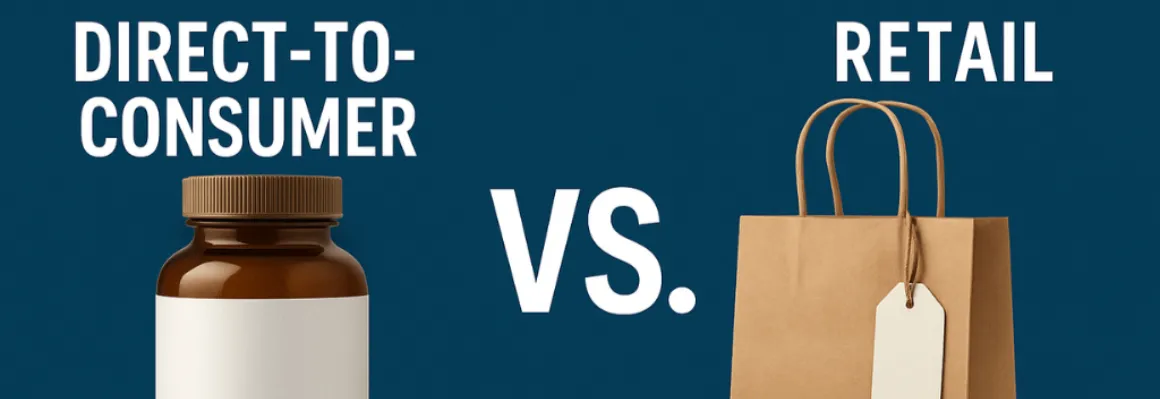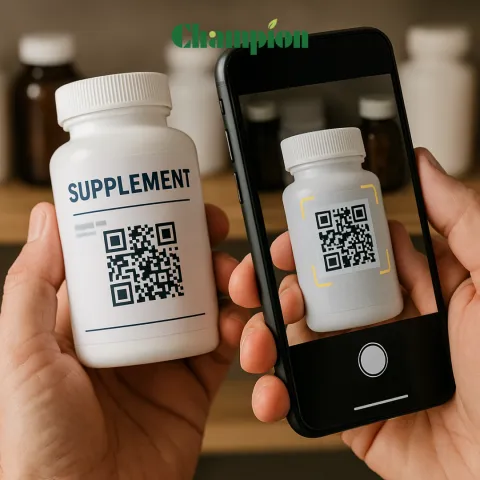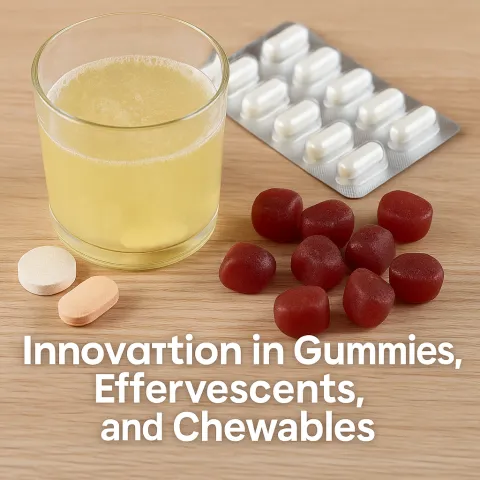Blog
15.Oct.2025
Direct-to-Consumer vs. Retail: Where Are Supplements Selling Fastest?

Introduction
The supplement industry is riding a wave of change, with sales channels evolving as fast as consumer preferences. In 2025, the once-dominant retail landscape is being rapidly disrupted by direct-to-consumer (DTC) brands, eCommerce marketplaces, and social commerce. But where are supplements selling fastest, and what strategies help brands break through noise in both digital and brick-and-mortar sectors? Here’s a deep dive into the supplement sales channels battle—DTC vs. retail, eCommerce vs. brick-and-mortar—and the trends that separate the winners from the rest.The Global Shift: Supplement Channel Mix in 2025
- The global dietary supplement market is projected to reach $521.4 billion by the end of 2025, with eCommerce, DTC, and hybrid models fueling new growth.
- In Asia, nearly 52% of supplement market transactions already take place online; Southeast Asia sees the fastest eCommerce growth rates globally, with Vietnam and Malaysia over +70% year-on-year.
- North America and Europe are seeing legacy retail supplemented by a strong surge in DTC sales, subscriptions, and Amazon marketplace dominance, especially for young and midlife consumers.
DTC & E-Commerce: The Fastest Growing Channels
The DTC Advantage
- Growth & Margins: DTC supplement brands report higher profit margins (often 2x vs. retail), keep more revenue per sale, and have direct customer relationships enabling repeat business with subscriptions and bundling.
- Speed to Market: DTC lets brands launch new SKUs, test product-market fit, or pivot formulas quickly without retailer red tape.
- First-Party Data: Brands own customer insights, behaviors, and feedback, allowing personalized marketing and agile product development.
- Channel Trends:
- Brand websites with critical focus on SEO, influencer partnerships, and subscription models.
- Marketplaces (Amazon, iHerb, Tmall, Shopee, Lazada)—offering reach, logistics, and high visibility, though at the cost of platform fees and branded experience control.tmogroup
Social Commerce & Live Commerce
- Supplements sales via TikTok Shop, Instagram, Facebook Shop, and YouTube Live demos have exploded—especially in Asia and for fast-moving or trend-based products.
- Social commerce promotes viral discovery, especially among Gen Z (18–28), often triggering retail sell-outs after major influencer campaigns.
Retail: Brick-and-Mortar, Pharmacies, and Grocery
Why Traditional Retail Remains Strong
- Credibility & Discovery: Retail still offers instant trust, impulse buying, and a tangible experience. Shoppers discover new supplements through pharmacy, chain grocery stores, and premium retail.
- Bulk Volume: Legacy retail channels—Costco, Walmart, GNC, Boots—remain bulk order leaders, especially for established names and value brands.
- Practitioner Channels: Healthcare practitioners and natural product stores offer advice, cross-selling, and are critical for specialty/skincare/women’s health categories.
- Challenges: Fees, margins lost to distributors, inventory risk, and slower launch cycles—but trust from older or health-cautious demographics justifies the cost.
Channel Comparison Table
| Channel | Growth Rate 2025 | Key Strengths | Weaknesses/Challenges | Best-Suited For |
| DTC Website | 20–25% YoY | Margins, data, flexibility | Brand awareness, logistics | Niche, personalized, subscription |
| Amazon/Marketplace | 18% YoY | Visibility, traffic, trust | Competition, platform fees | Established brands, impulse buy |
| Social Commerce | 50%+ YoY (Asia) | Viral growth, low barrier | Trend volatility, short shelf | Fast-moving, influencer-driven |
| Brick Retail | 4–7% YoY | Trust, bulk discovery | Lower margin, slow to pivot | Legacy, value, new mass consumers |
| Practitioner | 6.5% YoY | Authority, cross-sell | Scale, reimbursement risk | Premium, specialty, chronic care |
Regional Spotlight
North America
- DTC is now 29% of supplement sales, up from 16% in 2020.
- Amazon/eCommerce and retail “omnichannel” approaches (online + shelf) perform best—legacy retail remains key for volume, DTC for margin and loyalty.
Asia-Pacific
- E-commerce dominates; Shopee, Lazada, Tmall, and JD.com drive >50% of supplement spending in Southeast Asia and China.
- Social/live commerce and super app integrations (Grab, GoTo) are fastest-growing, with health micro-influencers and wellness KOLs (key opinion leaders) critical for market launches.
Europe
- Blended DTC/retail channels, but regulatory complexity makes national pharmacy and grocery chains especially important for import brands.
- Practitioner recommendations and food store integrations are strong for vitamins, probiotics, and specialty blends.
Sales Channel Strategies: Best Practices for Winning in 2025
- Hybrid Model is King: Most winning supplement brands blend DTC, retail, and marketplaces for resilience and scale.
- SEO & Social Proof: DTC sales are won with content marketing, customer reviews, and aggressive influencer strategies—especially on TikTok and Instagram.
- Subscription & Bundling: DTC websites excel when offering routines, bundles, and loyalty rewards, keeping customers engaged month after month.
- In-Store Experience: Retailers attract with shelf demos, sampling, and expert advice—partnerships with pharmacies and grocery chains boost authority and exposure.
- Data-Driven Pivoting: Use real-time analytics to shift inventory, product mix, and channel priority based on sales performance.
Challenges and Watch-Outs
- Customer Acquisition Costs: DTC success depends on digital marketing expertise and up-front investment in ads, influencers, and content— ROAS must be tracked tightly.
- Inventory/Logistics: Omnichannel distribution means mastering warehousing, fulfillment, and returns/satisfaction in multiple formats.
- Compliance: Labeling, claims, and regional rules vary widely; DTC channels face the same regulatory scrutiny as retail for all marketing and claims.
Case Studies
DTC Success Example:A plant-based supplement brand launched exclusively online, using TikTok and Instagram to drive 10,000+ orders/month. A mix of influencer viral campaigns and subscription offers powered a 23% conversion rate, with direct customer data fueling rapid product iteration.
Omnichannel Win Example:
A legacy vitamin company modernized its DTC website, kept strong retail partnerships, and expanded to Amazon Prime. This hybrid approach led to 40% eCommerce sales growth in a flat retail channel.
FAQs: Supplement Sales Channels
Q: Are supplements selling faster online or in-store in 2025?A: Online—especially via DTC and social commerce. Most regions report double-digit eCommerce growth, but in-store remains dominant for older consumers and high-trust products.
Q: What products do best on DTC channels?
A: Personalized, trendy, or influencer-backed supplements, unique delivery formats, and subscription-based wellness regimens lead online. Value brands, everyday vitamins, and practitioner-recommended supplements perform better at retail.
Q: What are the top growth markets for online supplement sales?
A: Southeast Asia (71–83% YoY online growth), China (+60% YoY eComm), and North America (DTC + Amazon) lead globally.
Conclusion
Supplements are selling fastest where brands meet shoppers—on their phones, through their feeds, and in-store for trust. In 2025, the winners use every channel: perfecting DTC and retail, blending viral campaigns with authority, and optimizing every customer touchpoint. Success means being everywhere the consumer is—responsive, data-driven, and ready for what comes next.Ready to win in supplement sales?
Contact our experts for a multi-channel strategy, content roadmap, and digital launch support tailored to the dynamic 2025 market.



















